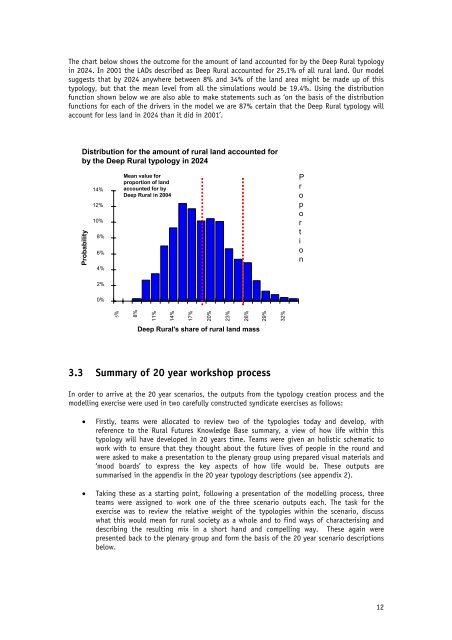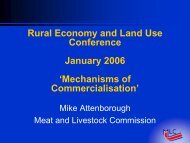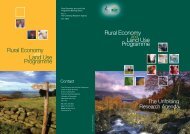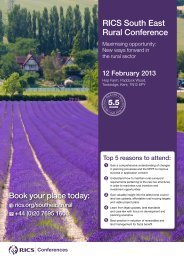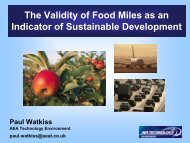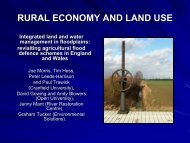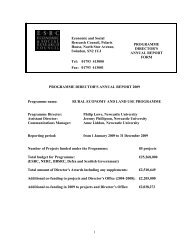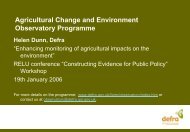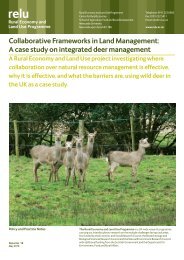Future Society in 2024: 21st Century 'Good Life' - Rural Economy ...
Future Society in 2024: 21st Century 'Good Life' - Rural Economy ...
Future Society in 2024: 21st Century 'Good Life' - Rural Economy ...
Create successful ePaper yourself
Turn your PDF publications into a flip-book with our unique Google optimized e-Paper software.
The chart below shows the outcome for the amount of land accounted for by the Deep <strong>Rural</strong> typology<br />
<strong>in</strong> <strong>2024</strong>. In 2001 the LADs described as Deep <strong>Rural</strong> accounted for 25.1% of all rural land. Our model<br />
suggests that by <strong>2024</strong> anywhere between 8% and 34% of the land area might be made up of this<br />
typology, but that the mean level from all the simulations would be 19.4%. Us<strong>in</strong>g the distribution<br />
function shown below we are also able to make statements such as ‘on the basis of the distribution<br />
functions for each of the drivers <strong>in</strong> the model we are 87% certa<strong>in</strong> that the Deep <strong>Rural</strong> typology will<br />
account for less land <strong>in</strong> <strong>2024</strong> than it did <strong>in</strong> 2001’.<br />
Distribution for the amount of rural land accounted for<br />
by the Deep <strong>Rural</strong> typology <strong>in</strong> <strong>2024</strong><br />
Probability<br />
14%<br />
12%<br />
10%<br />
8%<br />
6%<br />
4%<br />
Mean value for<br />
proportion of land<br />
accounted for by<br />
Deep <strong>Rural</strong> <strong>in</strong> 2004<br />
P<br />
r<br />
o<br />
p<br />
o<br />
r<br />
t<br />
i<br />
o<br />
n<br />
2%<br />
0%<br />
5%<br />
8%<br />
11%<br />
14%<br />
17%<br />
20%<br />
23%<br />
26%<br />
29%<br />
Deep <strong>Rural</strong>'s share of rural land mass<br />
32%<br />
3.3 Summary of 20 year workshop process<br />
In order to arrive at the 20 year scenarios, the outputs from the typology creation process and the<br />
modell<strong>in</strong>g exercise were used <strong>in</strong> two carefully constructed syndicate exercises as follows:<br />
• Firstly, teams were allocated to review two of the typologies today and develop, with<br />
reference to the <strong>Rural</strong> <strong>Future</strong>s Knowledge Base summary, a view of how life with<strong>in</strong> this<br />
typology will have developed <strong>in</strong> 20 years time. Teams were given an holistic schematic to<br />
work with to ensure that they thought about the future lives of people <strong>in</strong> the round and<br />
were asked to make a presentation to the plenary group us<strong>in</strong>g prepared visual materials and<br />
‘mood boards’ to express the key aspects of how life would be. These outputs are<br />
summarised <strong>in</strong> the appendix <strong>in</strong> the 20 year typology descriptions (see appendix 2).<br />
• Tak<strong>in</strong>g these as a start<strong>in</strong>g po<strong>in</strong>t, follow<strong>in</strong>g a presentation of the modell<strong>in</strong>g process, three<br />
teams were assigned to work one of the three scenario outputs each. The task for the<br />
exercise was to review the relative weight of the typologies with<strong>in</strong> the scenario, discuss<br />
what this would mean for rural society as a whole and to f<strong>in</strong>d ways of characteris<strong>in</strong>g and<br />
describ<strong>in</strong>g the result<strong>in</strong>g mix <strong>in</strong> a short hand and compell<strong>in</strong>g way. These aga<strong>in</strong> were<br />
presented back to the plenary group and form the basis of the 20 year scenario descriptions<br />
below.<br />
12


